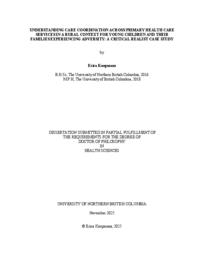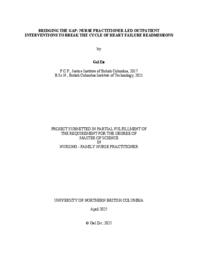Schiller, Catharine
Person Preferred Name
Catharine Schiller
Related Works
Content type
Digital Document
Origin Information
Content type
Digital Document
Description / Synopsis
Shared decision-making (SDM) is central component of patient-centered care and is of
particular interest in contraceptive counselling, where a range of potentially suitable options are
available, and personal preferences and values must guide clinical decisions. A systematic search
was conducted in MEDLINE (via Ovid) and CINAHL to identify qualitative, quantitative, and
mixed-methods studies published between 2019 and 2024. Inclusion criteria focused on studies
evaluating SDM tools or strategies in clinic-based settings with women of reproductive age.
Among the seven articles included in this review, a variety of SDM tools and strategies were
used: decision aids, interview guides, provider prompts, and physical models. Key outcomes
included improved patient satisfaction, decisional certainty, interpersonal quality of
contraceptive counselling, perceived self-efficacy in decision-making and increased
contraceptive knowledge. However, there was variability in how SDM was measured and
whether outcomes were explicitly linked to SDM processes. Findings suggest that effective
implementation of SDM tools or strategies in primary care practice may require a multifaceted
approach involving both pre-visit patient tools and provider and patient supports during
contraceptive counselling. Future research should seek to more clearly establish causal links
between SDM strategies and outcomes, and to evaluate SDM tools or strategies in the Canadian
context.
Origin Information
Content type
Digital Document
Description / Synopsis
Depression during the perimenopausal transition is a significant concern for women’s
mental health and quality of life. Hormone Replacement Therapy (HRT), traditionally used to
manage vasomotor and genitourinary symptoms of menopause, has also been investigated for its
potential to alleviate depressive symptoms associated with hormonal fluctuations. This
integrative literature review examined the impact of HRT on depression in perimenopausal
women by analyzing articles published between 2014 and 2025, reflecting the most recent
evidence following shifts in clinical practice post-Women’s Health Initiative. A comprehensive
search strategy using Medline (Ovid), CINAHL (EBSCO), PsycINFO (EBSCO), and Google
Scholar was employed, utilizing Medical Subject Headings (MeSH) and keywords. Six primary
studies met inclusion criteria and were critically appraised and synthesized. Key themes arising
out of the studies were the timing of HRT initiation, individual variability in depressive symptom
response, and methodological heterogeneity across studies. Findings suggest that HRT,
particularly transdermal estradiol, may be effective in reducing depressive symptoms when
initiated during early perimenopause. However, inconsistencies in study design, outcome
measures, and population definitions highlight the need for more standardized, high-quality
research. These findings have implications for nurse practitioners and other primary care
providers who play a critical role in screening, education, and patient-centered decision-making
in the management of menopausal mental health.
Origin Information
Content type
Digital Document
Description / Synopsis
Modifiable risk factors for cardiovascular health are often associated with healthy diet,
physical activity, and smoking cessation. Rarely is psychological stress mentioned or attributed
to cardiovascular disease (CVD). However, the literature is beginning to recognize psychological
stress as contributing to an increased risk of CVD (Aggarwal et al., 2021; Rippe, 2018; Walton et
al., 2002). Acute stress may impact the autonomic nervous system, increasing heart rate and
blood pressure, while chronic stress is associated with inflammation and the development of
atherosclerosis (Aggarwal et al., 2021; Ware, 2008). Healthcare guidelines remark on the need to
address modifiable risk factors in preventing and treating CVD (British Columbia [BC]
Guidelines, 2023; Jain et al., 2022; Pearson et al., 2021). However, the guidelines provide poor
directives regarding what intervention a practitioner should use, and how they should use it, to
reduce or manage patient stress. Furthermore, implementation of lifestyle interventions can be
challenging, and practitioners often face several barriers. Therefore, an integrative literature
review was conducted to identify stress-reducing interventions that primary care nurse
practitioners (NP) can implement when treating CVD. Nine articles were reviewed utilizing
Cooper’s (1982) systematic approach for integrative literature reviews, a method first published
in 1982 and frequently cited and used throughout the literature. Randomized controlled trials,
cohort studies, and qualitative research were included in this analysis. Unfortunately, this review
did not yield conclusive evidence that psychosocial interventions can achieve statistically
significant results in the treatment of CVD compared to standard CVD treatment. Nevertheless,
the practice recommendations are that psychosocial stress should be assessed and monitored for
those with CVD, and that lifestyle interventions should continue to be promoted as adjuncts to
traditional treatment regimes.
Origin Information
Content type
Digital Document
Description / Synopsis
Cervical cancer incidence continues to rise across Canada. Unlike some other cancers,
cervical cancer is largely preventable through a combination of vaccination and routine
screening. Cervical cancer screening was introduced in British Columbia in 1955 using the
Papanicoulau smear which requires a cervical specimen be obtained during a pelvic exam.
However, the pelvic exam has been identified by patients as a barrier to participation in cervical
cancer screening. Today, vaginal human papillomavirus testing provides a safe, validated
alternative to the Papanicoulau smear. Importantly, the human papillomavirus specimen can be
collected by patients themselves using a vaginal swab, thereby removing pelvic exam-related
barriers to cervical cancer screening. Specimen self-collection tends to be preferred by patients,
however primary care providers' perspectives on its use are not known. Primary care providers,
including nurse practitioners, have the potential to impact their patients' health behaviours, and
as such, understanding providers' perspectives on the use of self-collection is an important
consideration in order to reduce the burden of cervical cancer.
Origin Information
Content type
Digital Document
Description / Synopsis
Synthesizing the findings from diverse methodologies, this integrative review aimed to
guide nurse practitioners (NPs) in supporting the mental health and wellbeing of Syrian adults
with refugee experiences in Canada (Syrian Adults). A comprehensive search strategy was
conducted in three databases (APA PsycInfo, MEDLINE with Full Text (EBSCO) and Web of
Science), Google Scholar and Google Search Engine to identify relevant literature. Twelve
publications met the inclusion criteria and were critically appraised. The analysis of these
publications led to the identification of four key themes: (1) Correlates and Social Determinants
of Mental Health, (2) Cultural and Linguistic Considerations (including the subthemes of Stigma
and Perceptions of Mental Distress; and Screening and Self-Report Tools), (3) Non-Clinical
Facilitators of Mental Wellbeing, and (4) Trauma and Provision of Trauma-Informed Care. The
findings of this integrative review highlight the importance for NPs to build their foundational
knowledge to provide comprehensive, culturally appropriate, and trauma-informed care. Key
strategies include the use of validated mental health screening tools tailored for Arabic-speaking
and/or refugee populations, fostering trust and safety through an awareness of the role of stigma
and trauma in mental health care, utilizing interpreters and cultural brokers where appropriate,
and assessing social determinants of health during routine assessments. This review also
emphasizes the importance of interagency collaboration and ongoing professional development
in cross-cultural mental health to support access to care and mental wellbeing for Syrian Adults.
Origin Information
Content type
Digital Document
Description / Synopsis
Background: The increasing complexity of trauma care and provider shortages have led to
the expanded role of nurse practitioners (NPs). While NPs are integrated into various
healthcare settings, their influence on length of stay (LOS) for adult trauma patients remains
an area of interest, particularly from a qualitative perspective.
Objective: This integrative review explores qualitative findings on how NPs can influence
LOS in adult trauma patients, identifying potential contributions such as care coordination,
efficiency, and provider workload.
Methods: A systematic search of CINAHL, MEDLINE, and Google Scholar was conducted
to identify qualitative studies that examined the impact of NPs on LOS in adult trauma care.
Using an integrative review approach, data were analyzed to assess how NPs influence LOS.
Key themes were synthesized, LOS outcomes were reported, and the generalizability and
applicability of the integrative review findings were discussed.
Results: Findings suggest NPs contribute to reduced LOS by improving care coordination,
enhancing multidisciplinary communication, and facilitating discharge planning. However,
the extent of their impact remains unclear due to limited evidence.
Conclusion: While NPs are described as valuable members of trauma teams, their specific
impact on LOS in adult trauma patients is not well established in the qualitative literature.
Further research is needed to explore this relationship and determine whether NP-led
interventions can effectively reduce LOS.
Keywords: trauma service, trauma center, trauma centre, trauma unit, nurse practitioner,
advance practice nurse, trauma nurse practitioner, length of stay, LOS, impact on length of
stay, hospital length of stay.
Origin Information
Content type
Digital Document
Description / Synopsis
Cervical cancer (CC) remains a major public health concern, disproportionately affecting
low-income populations due to barriers in screening and follow-up care. Inadequate follow-up
after a positive HPV self-sample result puts individuals at higher risk of disease progression, yet
there is limited research on effective follow-up strategies for this group. This integrative review
explores interventions aimed at improving adherence to follow-up care in low-income women.
A systematic search identified eight studies examining follow-up interventions in lowincome populations. Follow-up rates varied widely (5.6%–92%), with higher adherence observed
when multiple follow-up methods were used, such as phone calls, text messages, postal mail, and
home visits. Patient education, patient navigation, and the provision of a second self-sampling kit
also showed promise in increasing follow-up rates. However, inconsistencies in study
methodologies and healthcare settings make direct comparisons challenging.
These findings highlight the need for standardized, evidence-based follow-up strategies
to address disparities in CC care. Future research should focus on scalable, cost-effective
interventions, including mobile health (mHealth) approaches and patient navigation models.
Policy efforts should prioritize integrating multi-modal follow-up strategies into national
screening programs to improve outcomes for vulnerable populations.
Origin Information
Content type
Digital Document
Description / Synopsis
Aim: To explore whether Nurse Practitioner-led outpatient interventions targeting heart failure
patients can reduce hospital readmissions or emergency department visits, thereby improving
healthcare efficiency and demands on hospitals.
Background: Heart failure is a leading cause of hospital readmissions, contributing significantly
to healthcare system strain. Despite advancements in HF care, readmission rates remain high,
posing substantial clinical and financial burdens. Nurse Practitioners, with their expertise in
chronic disease management and holistic care, are well-positioned to address these challenges
through proactive, personalized post-discharge care.
Method: An integrative review synthesizing most recent evidence on Nurse Practitioner-led
outpatient care models for heart failure patients, focusing on their impact on readmissions and
emergency department visits.
Results: Evidence suggests that Nurse Practitioner-led interventions improve post-discharge
continuity of care, reducing preventable readmissions and emergency department visits. These
models effectively target key factors contributing to readmissions, including medication
adherence, dietary management, patient education, and timely patient follow-ups. Although no
ethical concerns were identified, additional rigorous research across diverse populations and
settings is necessary to solidify the evidence base and guide widespread implementation.
Conclusion: Nurse Practitioner-led care presents a viable and scalable strategy to improve
outcomes in heart failure management and alleviate healthcare system pressures. Further
research and policy support are crucial to expand and standardize these programs.
Origin Information
Content type
Digital Document
Origin Information










